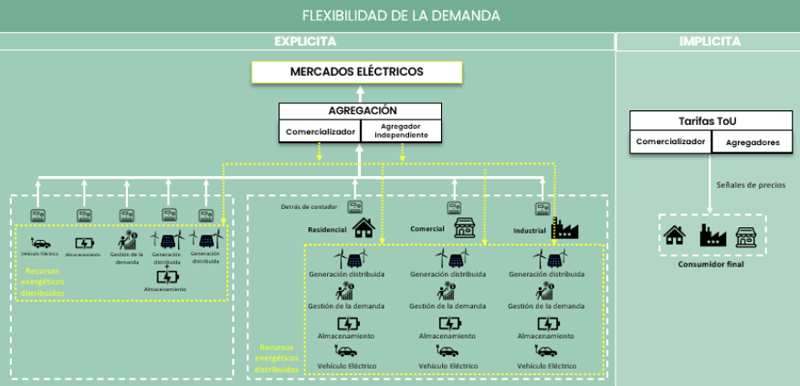These days we are seeing news in the media1 about the possibility of blackouts in the coming years. This news has its roots in a report published by Red Eléctrica de España entitled “National Resource Adequancy Assessment“2 .

It summarises the conclusions of the latest analysis of the system´s ability to safely meet demand. The indicator used to make these estimates is the loss of load expectation (LOLE) indicator. This index measures the number of hours during which, in a given geographical area and in a given period of time, energy production will not be sufficient to meet demand. A LOLE of 0.94 hours/year, is considered acceptable,which means that 99.99% of the time production has to meet demand. However the Red Eléctrica de España report estimates that the LOLE could be 5.63 hours/year in 2024, 6.26 hours/year in 2025 and as high as 7.14 hours/year in 2027 if the planned energy storage is not implemented. In terms of energy deficit, these LOLE translate into 9.38 GWh/year in 2024, 12.9 GWh/year in 2025 and 15.68GWh/year in 2027. The cause of this energy deficit in the Spanish electric system would be the possible dismantling of a certain volume of combined cycle plants that would no longer be profitable due to competition from renewable generation. It would be interesting to know whether the LOLE could be even more adversely affected by the expected closure of Spanish nuclear power plants.
I would like to reflect here on the possible mitigating effect that demand flexibility management could have. As is well known, demand flexibility is the ability of consumers to change their consumption profile in response to a request to do so. Ideally this would be done in exchange for some form of compensation, ideally financial. In a study3 we published a couple of years ago, we concluded that Spanish domestic demand could, thanks to its flexibility, be reduced by up to 2 GWh in winter and more than 10 GWh in the summer months. It is true that these figures would be given in an ideal situation and that they depend on the area of Spain we are looking at. A similar study4 provides more conservative estimates, but these can be as high as 3 GWh depending on various factors. In both studies, flexibility is provided by domestic electrical loads such as heat pumps, air conditioners or electric water heaters. Therefore, flexible energy depends on weather conditions and, of course, on the number of consumers who would like to participate in a demand flexibility management scheme. But above all, it will depend on whether regulation and business models evolve to make it a reality for households and small and medium-sized businesses to be able to offer their flexibility through a mechanism that remunerates them in a way that is not only cost-effective but also profitable. Ways to achieve this goal have been proposed, as in the case of the Entra partnership roadmap5, but Spain is still lagging behind other EU countries on this issue.
For large consumers, there are ways to sell their demand flexibility. In October 2022, the first auction of the new Active Demand Response Service (ADRS) was held, in which 699 MW were offered and 497 MW were allocated at a price of 69.97 €/MW. A new auction is planned for 2023, after the National Commission for Markets and Competition has revised the corresponding regulatory framework6. In addition to this, demand can participate in balancing markets, but the requirement to make minimum bids of 1 MW makes it impossible for non-big consumers to participate. Energy communities or aggregations of consumers are therefore practically excluded from this possibility.

Source: http://entra-coalicion.com/ya-disponible-la-hoja-de-ruta-para-la-flexibilidad-de-la-demanda
A demand flexibility service that is taking shape is peak shaving. This service, still under study, will reduce peak demand and is designed to facilitate the integration of renewable energies. The service is presented as something that will contribute to energy savings. How much energy can be saved is, for the moment, a mystery. In conclusion, we could say that demand flexibility could mobilise significant amounts of energy, but it does not seem easy to cover the energy deficit that has been predicted in the National Analysis of Coverage of the Peninsular Electricity System, although it could help to alleviate it. To remedy it would require a vigorous regulatory, technological, commercial and social effort to convince as many consumers as possible of the benefits of demand response. This does not appear to be easy to achieve.
1 https://www.eleconomista.es/energia/noticias/12567388/12/23/espana-tendra-riesgo-de-apagones-hasta-2030.html#1648118541665_forum
2 https://www.ree.es/sites/default/files/01_ACTIVIDADES/Documentos/informe_os_nov23.pdf
3 https://www.mdpi.com/1996-1073/14/6/1711
4 https://www.sciencedirect.com/science/article/pii/S0301421521001518
5 http://entra-coalicion.com/ya-disponible-la-hoja-de-ruta-para-la-flexibilidad-de-la-demanda
6 https://www.cnmc.es/prensa/marco-regulatorio-srad-20231024
- The 28A blackout and the lessons to be learned about the energy transition - 23 May 2025
- We ran out of light - 5 April 2024
- Uncertainties in electricity supply - 15 December 2023
